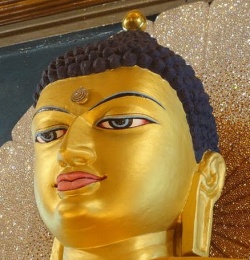Difference between revisions of "Selflessness of phenomena"
Jump to navigation
Jump to search
m (1 revision: Adminos 18 november) |
|||
| (One intermediate revision by the same user not shown) | |||
| Line 1: | Line 1: | ||
[[File:Buddh on Flicrk.jpg|thumb|250px|]] | [[File:Buddh on Flicrk.jpg|thumb|250px|]] | ||
| − | '''[[Selflessness]] of [[phenomena]]''' (Skt. ''[[dharmanairātmya]]''; Wyl. ''[[chos kyi bdag med]]'') — the absence of any intrinsic [[Wikipedia:Identity (social science)|identity]] in [[dharmas]], i.e., things and events. | + | '''[[Selflessness]] of [[phenomena]]''' (Skt. ''[[dharmanairātmya]]''; [[Wyl.]] ''[[chos kyi bdag med]]'') — the absence of any intrinsic [[Wikipedia:Identity (social science)|identity]] in [[dharmas]], i.e., things and events. |
==[[Selflessness]] of [[Phenomena]] in the Lower [[Yanas]]== | ==[[Selflessness]] of [[Phenomena]] in the Lower [[Yanas]]== | ||
| − | The great [[Sakya]] [[scholar]] [[Gorampa Sonam Senge]] says the [[selflessness]] of [[phenomena]] was taught in the [[Shravakayana]], but it was not taught clearly, extensively or completely. | + | The great [[Sakya]] [[scholar]] [[Gorampa Sonam Senge]] says the [[selflessness]] of [[phenomena]] was [[taught]] in the [[Shravakayana]], but it was not [[taught]] clearly, extensively or completely. |
| − | #It was not taught '''clearly''', meaning that there are only statements such as, ‘[[Form]] is like bubbles of [[water]], [[sensations]] are like foam.’ This is not as clear as the [[Mahayana]] teachings such as, ‘[[Form]] is [[empty]] of [[form]].’ | + | #It was not [[taught]] '''clearly''', meaning that there are only statements such as, ‘[[Form]] is like bubbles of [[water]], [[sensations]] are like foam.’ This is not as clear as the [[Mahayana]] teachings such as, ‘[[Form]] is [[empty]] of [[form]].’ |
| − | #It was not taught '''extensively''', meaning that only the [[phenomena]] included within the {{Wiki|continuum}} of one’s own [[aggregates]] were taught to be [[empty]]. By contrast, the [[Mahayana]] taught the [[twenty kinds of emptiness]]. | + | #It was not [[taught]] '''extensively''', meaning that only the [[phenomena]] included within the {{Wiki|continuum}} of one’s [[own]] [[aggregates]] were [[taught]] to be [[empty]]. By contrast, the [[Mahayana]] [[taught]] the [[twenty kinds of emptiness]]. |
| − | #It was not taught '''completely''', meaning that whilst there were teachings on the insubstantiality of one’s own [[aggregates]], this only serves as an antidote to the extreme of [[existence]]. Unlike those of the [[Mahayana]], such teachings do not address the absence of all [[four extremes]]. | + | #It was not [[taught]] '''completely''', meaning that whilst there were teachings on the [[insubstantiality]] of one’s [[own]] [[aggregates]], this only serves as an antidote to the extreme of [[existence]]. Unlike those of the [[Mahayana]], such teachings do not address the absence of all [[four extremes]]. |
==See Also== | ==See Also== | ||
| Line 17: | Line 17: | ||
{{RigpaWiki}} | {{RigpaWiki}} | ||
| − | + | [[Category:Self]] | |
[[Category:Buddhist Philosophy]] | [[Category:Buddhist Philosophy]] | ||
Latest revision as of 07:00, 13 March 2015
Selflessness of phenomena (Skt. dharmanairātmya; Wyl. chos kyi bdag med) — the absence of any intrinsic identity in dharmas, i.e., things and events.
Selflessness of Phenomena in the Lower Yanas
The great Sakya scholar Gorampa Sonam Senge says the selflessness of phenomena was taught in the Shravakayana, but it was not taught clearly, extensively or completely.
- It was not taught clearly, meaning that there are only statements such as, ‘Form is like bubbles of water, sensations are like foam.’ This is not as clear as the Mahayana teachings such as, ‘Form is empty of form.’
- It was not taught extensively, meaning that only the phenomena included within the continuum of one’s own aggregates were taught to be empty. By contrast, the Mahayana taught the twenty kinds of emptiness.
- It was not taught completely, meaning that whilst there were teachings on the insubstantiality of one’s own aggregates, this only serves as an antidote to the extreme of existence. Unlike those of the Mahayana, such teachings do not address the absence of all four extremes.
See Also
Further Reading
- The Light of Wisdom, Volume 1. Root text by Padmasambhava and commentary by Jamgön Kongtrül the Great. Published by Shambhala Publications ISBN 0-87773-566-2, pages 135-141.
- Khenpo Ngawang Pelzang, A Guide to the Words of My Perfect Teacher, translated by Padmakara Translation Group, published by Shambhala Publications, ISBN 1-59030-073-4, pages 210-213.
